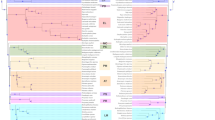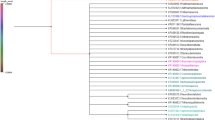Abstract
Sequencing the complete mitochondrial genome of four individuals of two subspecies of black-billed capercaillie Tetrao parvirostris parvirostris (mainland population) and T. p. kamtschaticus (Kamchatka Peninsula), family Tetraonidae, was arranged for the first time. Genetic divergence between mainland and Kamchatka subspecies was estimated as 0.1%, which corresponds to the level of individual variability. Compared to high haplotype diversity, a low nucleotide polymorphism of mtDNA was revealed and absence of inter-subspecies genetic differentiation was shown. Such absence may reflect the youth of the Kamchatka isolate and/or conservation of the mitochondrial genome for the species as a whole. Analysis of a fragment of the nuclear gene OCA2, encoding the transmembrane P protein and affecting the coloration, revealed the identity of the subspecies of mainland and Kamchatka. Such a clear lack of divergence by mitochondrial and nuclear markers between the mainland and Kamchatka populations of the capercaillie contradicts their morphological differences. Appearance of an isolated population of the black-billed capercaillie in Kamchatka was probably caused by either shrinking of the mainland part of formerly large range of the species that created the gap, or recent invasion from the mainland.


Similar content being viewed by others
REFERENCES
Lobkov, E.G., Kamchatka as a local center of morphogenesis in birds, in Biologiya i okhrana ptits Kamchatki (Bird Biology and Conservation in Kamchatka), Moscow: Dialog—Mosk. Gos. Univ., 1999, issue 1, pp. 5—23.
Lobkov, E.G., Gnezdyashchiesya ptitsy Kamchatki (Breeding Birds of Kamchatka), Vladivostok: Dal’nevost. Nauchn. Tsentr Akad. Nauk SSSR, 1986.
Kurentsov, A.I., Zoogeografiya Kamchatki (Zoogeograpy of Kamchatka), in Fauna Kamchatskoi oblasti (Fauna of the Kamchatka Oblast), in Trudy Kamchatskoi kompleksnoi ekspeditsii (Proceedings of the Kamchatka Complex Expedition), Moscow: Akad. Nauk SSSR, 1963, pp. 4—60.
Potapov, R.L., Otryad Kuroobraznye (Galliformes). Semeistvo teterevinye (Tetraonidae) (Order Galliformes. Family Tetraonidae), Leningrad: Nauka, 1985.
Potapov, R.L., Black-billed capercaillie—Tetrao urogalloides Middendorff, 1851, in Ptitsy SSSR: kuroobraznye, zhuravleobraznye (Birds of the Soviet Union: Galliformes and Gruiformes), Leningrad: Nauka, 1987, pp. 186—197.
Khotinskii, N.A., Golotsen Severnoi Evrazii: opyt transkontinental’noi korrelyatsii etapov razvitiya rastitel’nosti i klimata (Holocene of Northern Eurasia: The Experience of Transcontinental Correlation of the Development Stages in Vegetation and Climate), Khotinskii, N.A., Ed., Moscow: Nauka, 1977.
Dirksen, V., Dirksen, O., and Diekmann, B., Holocene vegetation dynamics and climate change in Kamchatka Peninsula, Russian Far East, Rev. Palaeobot. Palynol., 2013, vol. 190, pp. 48—65. https://doi.org/10.1016/j.revpalbo.2012.11.010
Lobkov, E.G., Penzhina River basin birds, Ornitologiya, 2011, issue 36, pp. 39—102.
Stejneger, L., Results of Ornithological Explorations in the Commander Islands and in Kamchatka, vol. 29 of Bulletin of the United States National Museum, Washington : Government Printing Office, 1885. https://doi.org/10.5479/si.03629236.29.1.
Bianki, V.V., Report on a business trip to Kamchatka in 1908, Izv. Imp. Akad. Nauk, 1909, vol. 1, no. 6, pp. 23—52.
Averin, Yu.V., Birds of the Kamchatka Peninsula, Extended Abstract of Doctoral Dissertation, Zool. Inst. Akad. Nauk SSSR, Leningrad, 1958.
Portenko, L.A., Sketch of the Bird fauna of the Koryak Highlands, in Problemy ornitologii (Challenges in Ornitology), L’vov, 1964, pp. 57—66.
Lobkov, E.G., Birds of Kamchatka (geography, ecology, conservation strategy), Doctoral (Biol.) Dissertation, 2003.
Bonfield, J.K., Smith, K.F., and Staden, R., A new DNA sequence assembly program, Nucleic Acids Res., 1995, vol. 23, pp. 4992—4999.
Kumar, S., Stecher, G., and Tamura, K., MEGA7: molecular evolutionary genetic analysis version 7.0 for bigger datasets, Mol. Biol. Evol., 2016, vol. 33, pp. 1870—1874. https://doi.org/10.1093/molbev/msw054
Nei, M., Molecular Evolutionary Genetics, New York: Columbia Univ. Press, 1987.
Librado, P. and Rozas, J., DnaSP v5: a software for comprehensive analysis of DNA polymorphism data, Bioinformatics, 2009, vol. 25, pp. 1451—1452. https://doi.org/10.1093/bioinformatics/btp187
Drovetski, S.V., Molecular phylogeny of grouse: individual and combined performance of W-linked, autosomal, and mitochondrial loci, Syst. Biol., 2002, vol. 51, no. 6, pp. 930—945. https://doi.org/10.1080/10635150290156033
Dimcheff, D.E., Drovetski, S.V., and Mindell, D.P., Phylogeny of Tetraonidae and other galliform birds using mitochondrial 12S and ND2 genes, Mol. Phyl. Evol., 2002, vol. 24, pp. 203—215. https://doi.org/10.1016/S1055-7903(02)00230-0
Lucchini, V., Hoglund, J., Klaus, S., et al., Historical biogeography and a mitochondrial DNA phylogeny of grouse and ptarmigan, Mol. Phyl. Evol., 2001, vol. 20, no. 1, pp. 149—162. https://doi.org/10.1006/mpev.2001.0943
ACKNOWLEDGMENTS
We express our deep appreciation to the Kamchatka hunters V.V. Smirnov, P.P. Sychev, and Yu.F. Mulyar for collecting and delivering samples of capercaillie from the Kamchatka Peninsula and the basin of the Penzhina River. The results were obtained using the equipment of the Shared Access Center Far Eastern Computing Resource of the Institute of Automation and Control Processes, Far Eastern Branch, Russian Academy of Sciences (https://www.cc.dvo.ru).
Funding
This work was supported by the program Far East of the Presidium of the Far Eastern Branch of the Russian Academy of Sciences, grant no. 18-4-031.
Author information
Authors and Affiliations
Corresponding author
Ethics declarations
COMPLIANCE WITH ETHICAL STANDARDS
All applicable international, national, and/or institutional guidelines for animal care and use were followed.
CONFLICT OF INTEREST
The authors declare that they have no conflict of interest.
Rights and permissions
About this article
Cite this article
Spiridonova, L.N., Lobkov, E.G., Shedko, S.V. et al. Genetic Homogeneity of the Black-Billed Capercaillie Subspecies Tetrao parvirostris parvirostris Bonaparte, 1856 and T. p. kamtschaticus Kittlitz, 1858 (Tetraonidae, Aves) Based on the Mitochondrial and Nuclear DNA Data. Russ J Genet 56, 454–459 (2020). https://doi.org/10.1134/S1022795420040134
Received:
Revised:
Accepted:
Published:
Issue Date:
DOI: https://doi.org/10.1134/S1022795420040134




